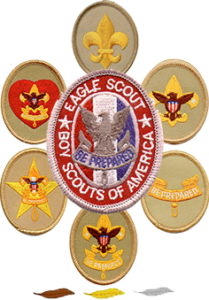
Mission Statement:
The mission of the Boy Scouts of America is to prepare young people to make ethical and moral choices over their lifetimes by instilling in them the values of the Scout Oath and Scout Law.
The Aims of Scouting
- Character development
- Citizenship training
- Mental and physical fitness
Scouting Methods:
The BSA has eight methods it employs to fulfill its aims:
- Ideals: The ideals of Boy Scouting are spelled out in the Scout Oath, the Scout Law, the Scout motto, and the Scout slogan. The Boy Scout measures himself against these ideals and continually tries to improve. The goals are high, and, as he reaches for them, he has some control over what and who he becomes.
- Patrols: The patrol method gives Boy Scouts an experience in group living and participating citizenship. It places responsibility on young shoulders and teaches boys how to accept it. The patrol method allows Scouts to interact in small groups where they can easily relate to each other. These small groups determine troop activities through their elected representatives.
- Outdoor Programs: Boy Scouting is designed to take place outdoors. It is in the outdoor setting that Scouts share responsibilities and learn to live with one another. It is here that the skills and activities practiced at troop meetings come alive with purpose. Being close to nature helps Boy Scouts gain an appreciation for God’s handiwork and humankind’s place in it. The outdoors is the laboratory for Boy Scouts to learn ecology and practice conservation of nature’s resources.
- Advancement: Boy Scouting provides a series of surmountable obstacles and steps in overcoming them through the advancement method. The Boy Scout plans his advancement and progresses at his own pace as he meets each challenge. The Boy Scout is rewarded for each achievement, which helps him gain self-confidence. The steps in the advancement system help a Boy Scout grow in self-reliance and in the ability to help others. The four steps for advancement are:
- Learn
- Test
- Review
- Recognize
- Association with Adults: Boys learn a great deal by watching how adults conduct themselves. Scout leaders can be positive role models for the members of their troops. In many cases a Scoutmaster who is willing to listen to boys, encourage them, and take a sincere interest in them can make a profound difference in their lives.
- Personal Growth: As Boy Scouts plan their activities and progress toward their goals, they experience personal growth. The Good Turn concept is a major part of the personal growth method of Boy Scouting. Boys grow as they participate in community service projects and do Good Turns for others. Probably no device is so successful in developing a basis for personal growth as the daily Good Turn. The religious emblems program also is a large part of the personal growth method. Frequent personal conferences with his Scoutmaster help each Boy Scout to determine his growth toward Scouting’s aims.
- Leadership Development: The Boy Scout program encourages boys to learn and practice leadership skills. Every Boy Scout has the opportunity to participate in both shared and total leadership situations. Understanding the concepts of leadership helps a boy accept the leadership role of others and guides him toward the citizenship aim of Scouting.
- Uniform: The uniform makes the Boy Scout troop visible as a force for good and creates a positive youth image in the community. Boy Scouting is an action program, and wearing the uniform is an action that shows each Boy Scout’s commitment to the aims and purposes of Scouting. The uniform gives the Boy Scout identity in a world brotherhood of youth who believe in the same ideals. The uniform is practical attire for Boy Scout activities and provides a way for Boy Scouts to wear the badges that show what they have accomplished.
Rank Categories
- Getting Started: Scout
- Scout Skills: Tenderfoot, Second Class and First Class
- Journey to Eagle: Star, Life, Eagle and Eagle Palms
Responsibilities
Tracking Personal Advancement
It is the Scout’s responsibility, by utilizing their Scout Handbook and Scout Binder, to keep track of their advancement progress. They should be tracking:
- Rank requirements
- Days camped
- Miles hiked, backpacked, biked, or floated
- Service projects/hours
- Leadership positions
- Blue Cards, Merit Badge Cards, & Rank Cards
Tracking Troop Advancement
It is the responsibility of the Troop Advancement Chair (adult leader) to track all Troop Advancement Activities and reporting them to the BSA in a timely fashion.
Sign-off Authority
- Rank:
- Troop Guide
- Senior Patrol
- Adult Leaders
- Merit Badges (more detailed information available on the Merit Badges page):
- Merit Badge Counselor
- Scoutmaster
- Advancement Chair
Parents’ Role
- Be your Scout’s cheerleader, this is their journey, not yours
- Encourage and motivate them
- Know that this is not a race…it is about having fun, developing life-long skills, and learning to become a good citizen and leader
- Ask to see their book & know who needs to sign off on requirements
- Make sure they attends meetings and events
Board of Review
- Prior to the Board of Review the Scout must complete a Scoutmaster Conference in full Class-A uniform.
- Board of Review consists of meeting with 3 to 6 troop adult leaders
- Scout must present themselves in full Class-A uniform
- Scout must recite the Scout Oath, Law, Motto and Slogan
- Scout must discuss how they have completed the rank requirements
- Scout must discuss their role within Troop, including leadership positions when appropriate
- The Board of Review must be a unanimous decision among the adult leaders
- The Board of Review typically lasts 15 to 30 minutes
Resources
- Troop 123 Advancement Guide (updated 2020)
- Troop 123 Guide to Merit Badges
- Activity Log
- Eagle Scout Application (as of June 2022)
- Service Hours Request Form